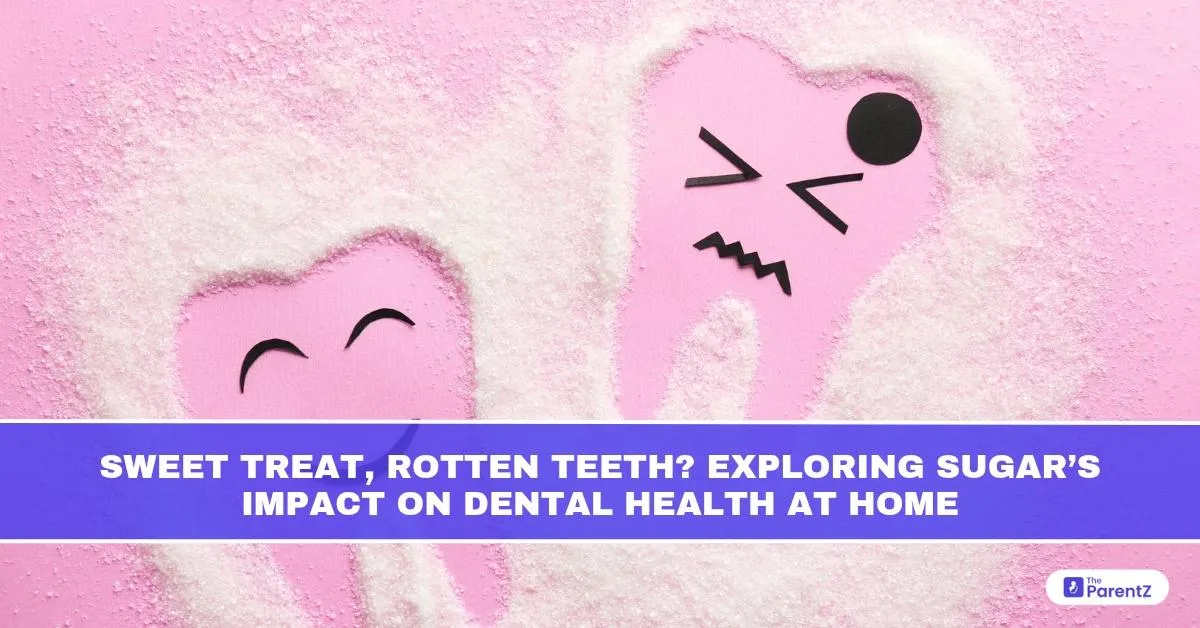Fun fact to begin with:
The average Indian child eats about 20–25 teaspoons of sugar every day, often without even realising it! From biscuits and flavoured milk to hidden sugars in ketchup and cereals, sugar sneaks into many everyday foods.
But what does sugar really do to our teeth? Can one extra ladoo after dinner actually hurt?
Today, let’s explore how sugar affects dental health and how you, as a parent, can help your child understand this in a fun, hands-on way. No scary dentist lectures here. Just science, smiles, and simple ways to raise a tooth-friendly child.
Why Sugar and Teeth Don’t Get Along
Tooth decay, or dental cavities, happens when bacteria in our mouths feed on sugar and produce acids. These acids attack the outer surface of the tooth called enamel, and over time, they create holes.
It’s not the sugar itself that causes cavities, but the chain reaction it starts:
- Sugar enters the mouth
- Mouth bacteria love sugar and feed on it
- Bacteria produce acids as a result
- Acid sits on the tooth surface and weakens the enamel
- Repeated exposure leads to decay
So while one sweet isn’t evil, constant snacking on sugary foods without proper brushing is what causes the real damage.
What Does Tooth Decay Look Like?
Early cavities might not hurt at all. That’s why they can go unnoticed. But over time, kids may experience:
- White spots on teeth
- Sensitivity to hot or cold food
- Pain when chewing
- Visible brown or black spots
- Bad breath
And if left untreated, cavities can lead to infection, tooth loss, or the need for painful dental treatments.
But the good news? It’s all preventable.
A Simple At-Home Experiment: Eggs as Teeth
Want to show your child exactly how sugar and acid can affect their teeth? Here’s a fun little science experiment you can try at home using a boiled egg.
What You’ll Need:
- 2 boiled eggs (with the shell intact)
- 2 clear glasses
- Cola or any sugary soda
- Water
- A toothbrush and toothpaste
What To Do:
- Place one egg in the glass of cola, and the other in the glass of water.
- Leave both glasses overnight.
- The next day, take them out and observe:
- Try brushing both eggs with toothpaste and a toothbrush.
What This Teaches:
The eggshell is a great stand-in for tooth enamel. The cola represents sugary drinks that soften and stain teeth. Your child will learn:
- How sugar + acid can damage the outer layer of teeth
- Why brushing is important after sugary food or drinks
- That some stains can’t be reversed even with brushing
Sugar in Disguise: Where It Hides
Kids often associate sugar with chocolates or sweets. But sugar hides in places they may not expect. Teaching them to recognise it builds good decision-making.
Here are some common examples of “hidden sugars”:
- Breakfast cereals marketed as “healthy”
- Flavored yoghurts
- Fruit juices and packaged milk drinks
- Energy bars
- Sauces like ketchup or mayonnaise
- Biscuits and bakery items
Turn it into a game: next time you shop, ask your child to spot the “sugar” in food labels. Look for words like glucose, sucrose, high-fructose corn syrup, and maltose.
Even better, choose a few items from your own kitchen shelf and read the ingredients together.
How to Protect Young Teeth Without Being Sugar-Strict
You don’t need to ban sweets completely to protect your child’s teeth. Instead, focus on timing, balance, and hygiene.
Here’s how:
1. Save sweets for meal times
The saliva flow is higher during meals, which helps wash away sugar. Encourage dessert with a meal rather than between meals.
2. Don’t let sugar sit on the teeth
Brush 30 minutes after eating anything sweet. If brushing isn’t possible, rinse the mouth with water thoroughly.
3. No bedtime sugar
Avoid giving milk, juice, or sugary snacks right before bed, especially if your child won’t be brushing again.
4. Make brushing non-negotiable
Twice a day, for two minutes. Use a fluoride toothpaste and supervise until at least age 7 or 8.
5. Offer teeth-friendly snacks
Cheese cubes, cucumber sticks, soaked nuts, roasted chana, and plain yoghurt are all excellent alternatives to sweets and chips.
6. Regular dental visits
Schedule a dental check-up every 6–12 months, even if there are no complaints. Prevention is cheaper and kinder than treatment.
Storytime Analogy: “Cavity Monsters”
For younger kids, turning dental health into a story is a great way to make it more engaging. Here’s one to try:
“There are tiny invisible monsters in your mouth. They’re called Cavity Monsters. They love sugar. Every time you eat a sweet and forget to brush, they throw a party and make holes in your teeth. But guess what? You have a superhero toothbrush and a fluoride shield. Use them every morning and night to chase those monsters away!”
This kind of visual storytelling makes dental health feel more like a game and less like a rule.
Make a Tooth Journal
Want to keep the learning going? Help your child start a “Tooth Journal.”
- Draw a big smile and color the teeth white
- Add a sticker or star every day they brush twice
- Track sugary snacks and healthy ones each week
- Reward with experiences like a picnic, playdate, or extra bedtime story not sugary treats
This makes oral hygiene a goal they’re invested in, not something they feel forced into.
In Conclusion
Sugar isn’t the villain, but how and when we consume it matters. By teaching your child the reason behind tooth brushing, you’re giving them a life skill, not just a habit.
This doesn’t mean saying no to every sweet. It means saying yes to awareness, moderation, and smart hygiene.
Try the egg experiment, read those labels, make brushing fun, and keep up the good work. Your child’s healthy, happy smile will thank you not just today, but for years to come.








Be the first one to comment on this story.